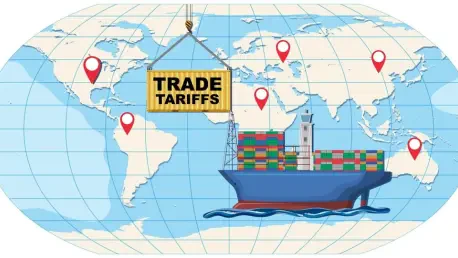Could a single policy tool wield enough power to shield American industries, disrupt global markets, and ignite diplomatic firestorms with just a signature? Tariffs, as wielded by President Donald Trump, have emerged as a lightning rod in the arena of international trade, transforming economic policy into a high-stakes chess game. With the stroke of a pen, these levies on imports have reshaped supply chains and challenged long-standing alliances, drawing both fervent support and sharp criticism. This deep dive explores the legal machinery behind Trump’s tariff strategy, the battles brewing in courtrooms, and the ripple effects felt across industries and borders.
Why Tariffs Dominate Headlines
At the heart of Trump’s trade agenda lies a bold promise: to protect American jobs and counter what the administration calls unfair practices by foreign nations. Tariffs, essentially taxes on imported goods, have become the centerpiece of this mission, affecting everything from steel to semiconductors. Their resurgence under Trump’s leadership has thrust trade policy into the spotlight, raising urgent questions about economic strategy and executive reach at a time when global tensions are already simmering.
The significance of this approach cannot be overstated. With investigations targeting goods that account for roughly 40% of U.S. trade, the potential impact on prices, supply chains, and consumer wallets is immense. Beyond economics, tariffs have become a symbol of a broader ideological clash over globalization versus national interest, making them a focal point for policymakers, businesses, and citizens tracking the balance of power in trade relations.
The High Stakes of a Trade Battleground
Trump’s tariff policies are not merely fiscal measures; they represent a calculated strike against trade imbalances and issues framed as national crises, such as fentanyl trafficking. By imposing these levies, the administration aims to bolster domestic industries like manufacturing and agriculture, which have long struggled against cheaper foreign competition. Yet, this strategy risks inflating costs for American consumers, as businesses pass on the added expenses of imported materials critical to sectors like technology and healthcare.
Internationally, the fallout is equally complex. Allies and adversaries alike have bristled at tariffs on their exports, threatening retaliatory measures that could escalate into broader economic conflicts. The strain on diplomatic ties, particularly with major trading partners, underscores a delicate balancing act: while the administration pushes a hardline stance, the potential for fractured alliances looms large, complicating efforts to maintain stability in an interconnected global economy.
Legal Weapons in the Tariff Arsenal
Trump’s authority to enact tariffs hinges on a robust set of statutory mechanisms, each tailored to specific circumstances but collectively forming a formidable toolkit. The International Emergency Economic Powers Act (IEEPA) stands out for its sweeping scope, allowing the president to declare emergencies and impose tariffs with little immediate oversight. However, its use is under fire, with federal courts challenging its legality for such purposes and a pivotal Supreme Court review looming on the horizon.
Other tools provide sturdier ground. Section 232 of the Trade Expansion Act of 1962 ties tariffs to national security, a justification upheld in past judicial rulings, covering vast swaths of trade like steel and pharmaceuticals. Similarly, Section 301 of the Trade Act of 1974 targets unfair trade practices, as seen in levies on Chinese imports, offering a legally tested option. Lesser-known provisions, such as Sections 338, 201, and 122, add further flexibility, addressing discriminatory practices, industry harm, or temporary trade deficits, though often with slower processes or limited durations.
Expert Perspectives and Looming Legal Clashes
Insights from trade and legal analysts shed light on the administration’s tactical approach. Alexander Schaefer, a trade law specialist, cautions that a Supreme Court ruling against IEEPA could curb executive power significantly, forcing a pivot to more structured mechanisms. Meanwhile, Greg Husisian, another expert in the field, emphasizes the resilience of Sections 232 and 301, describing them as “battle-hardened” due to prior court validations, providing a safety net amid uncertainty.
Judicial battles are already intensifying, with federal rulings questioning the breadth of emergency powers under IEEPA, setting the stage for a defining Supreme Court hearing. On the global front, opposition through the World Trade Organization (WTO) poses a threat, though experts note that the WTO’s current appellate gridlock may temporarily shield U.S. actions from enforceable consequences. This interplay of domestic and international challenges paints a picture of a policy under siege, yet backed by strategic redundancies.
Charting a Course Through Tariff Turbulence
For stakeholders navigating this volatile landscape, staying ahead requires a clear grasp of both risks and opportunities. Monitoring legal outcomes, especially the Supreme Court’s decision on IEEPA, is critical, as an adverse ruling could shift reliance toward slower but more defensible tools like Section 232. Businesses, particularly those dependent on imports like pharmaceuticals, must assess supply chain vulnerabilities and brace for potential cost surges or sourcing disruptions.
On a broader scale, anticipating retaliatory moves from trading partners is essential. With the WTO’s limited enforcement capacity, diplomatic engagement or alternative trade agreements may offer pathways to mitigate friction. These strategies, grounded in real-time adaptation, equip policymakers and industries to weather the uncertainties of Trump’s tariff-driven agenda, balancing immediate pressures with long-term planning.
Reflecting on a Divisive Legacy
Looking back, Trump’s tariff policies carved a contentious path through economic and political spheres, redefining the boundaries of presidential authority in trade warfare. The legal battles, from IEEPA challenges to the steadfast backing of other statutes, underscored a fierce tug-of-war between executive action and oversight. As industries grappled with shifting costs and global partners weighed retaliation, the impact reverberated far beyond U.S. borders.
Moving forward, the lessons from this era point toward a need for vigilance and adaptability. Businesses must prioritize resilience in supply chains, while policymakers face the task of rebuilding trust with trading partners. The ongoing evolution of legal precedents demands close attention, as future administrations will inherit both the tools and the tensions of this bold experiment in economic nationalism.









